Jewellery - Photo gallery
Image database with photographs of ancient art and antiquities
Our image database provides photographs of ancient art and antiquities for press releases as well as for private use. All artefacts sold in our gallery are documented through professional photographs. The resulting image library contains numerous ancient Egyptian, Greek and Roman antiquities as well as ancient coins. The time span from Stone Age, over Bronze Age and Classical Antiquity until Late Antiquity is covered.The photo gallery aims at providing a vast visual archive equipped with filters and search tools. You are most welcome to search the constantly growing number of artefacts in the image library. We are also happy to authorize hyperlinks from your webpage / forum to the objects depicted in our gallery. For this purpose, please send us a short notification prior to placing a hyperlink. For almost every object high definition photographs are available and can be provided e.g. to document your collection or for scientific papers or popular science articles. If you are interested in using pictures for publications, print media or other purposes, please contact us and we will be happy to assist you.
-
 Roman rosette brooch from Colchester
Roman rosette brooch from ColchesterA nice brooch type from the 1st century with an especially well preserved decorative disc. From the famous Hattatt collection and published in two standard works on ancient brooches.
Price: on request Disc brooch from Roman Britain
Disc brooch from Roman BritainNicely enameled brooch with a Romano-Celtic sunburst design. From the 2nd century AD. Published in two stardard works on ancient brooches by Richard Hattatt.
Price: on request Magnificent spectacle brooch from Greece
Magnificent spectacle brooch from GreeceThe very large bronze brooch was made between the 9th and 6th century BC. It is formed by a single piece of wire. With an old expertise from Nefer Gallery.
 Eastern Roman glass bottle with thread decoration
Eastern Roman glass bottle with thread decorationA product from the Roman province of Palaestina. The high-quality glass was created in the 6th to early 7th centuries, when the Eastern Roman Empire was thriving and the Byzantine Empire took shape.
 Three neolithic arrowheads from Egypt
Three neolithic arrowheads from EgyptThe Stone Age points are finely crafted. From a 100 year old museum collection.
Price: on request Three neolithic arrowheads from Egypt
Three neolithic arrowheads from EgyptThe Stone Age points are finely crafted. From a 100 year old museum collection.
 Three neolithic arrowheads from Egypt
Three neolithic arrowheads from EgyptThe Stone Age points are finely crafted. From a 100 year old museum collection.
Price: on request Late Roman glass vessel with thread decoration
Late Roman glass vessel with thread decorationA product from the province of Palaestina or Syria. The high-quality glass was created in the 4th or early 5th century, a time of upheaval for the Roman Empire.
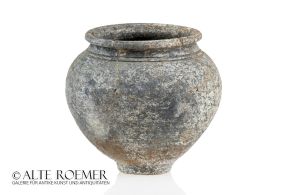 Römisches Töpfchen
Römisches TöpfchenGeborgen in den Jahren 1966 bis 1981 in Zusammenarbeit mit lokalen Archäologen. Neuss, das römische Novaesium, war eine frühe römische Gründung in der Provinz Germania Inferior und ist somit eine der ältesten Städte Deutschlands.
Price: on request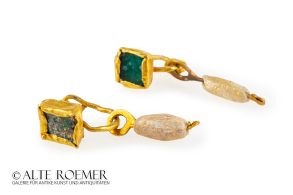 Pair of Roman gold earrings
Pair of Roman gold earringsThe earrings belong together originally. They are nicely decorated by beads and glass inserts. A beautiful pair of jewellery from the 3rd century.
Price: on request Phoenician eye bead
Phoenician eye beadPolychrome glass bead with stylized elements of a face as protection against the evil eye. Produced in Carthage or the Phoenician homeland, 4th to 3rd century BC.
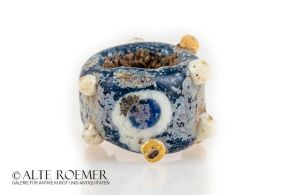 Phoenician eye bead
Phoenician eye beadPolychrome glass bead with stylized elements of a face as protection against the evil eye. Produced in Carthage or the Phoenician homeland, 4th to 3rd century BC.
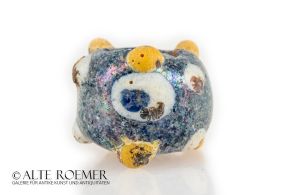 Phoenician eye bead
Phoenician eye beadPolychrome glass bead with stylized elements of a face as protection against the evil eye. Produced in Carthage or the Phoenician homeland, 4th to 3rd century BC.
Price: on request Phoenician eye bead
Phoenician eye beadPolychrome glass bead with stylized elements of a face as protection against the evil eye. Produced in Carthage or the Phoenician homeland, 4th to 3rd century BC.
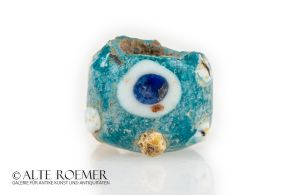 Phoenician eye bead
Phoenician eye beadPolychrome glass bead with stylized elements of a face as protection against the evil eye. Produced in Carthage or the Phoenician homeland, 4th to 3rd century BC.
Price: on request Stone Age bow scraper from Egypt
Stone Age bow scraper from EgyptThe Paleolithic tool is of beautiful shape and color. Thebes has been handed down as the place of origin. From an old museum collection.
Price: on request Paleolithic hand axe or borer
Paleolithic hand axe or borerPrehistoric stone tool. It was the universal tool of the older Stone age and could be used as a borer or chisel. From a Swiss museum collection. Found in the Algerian Sahara desert.
Price: on request Large prehistoric hand axe
Large prehistoric hand axeMassive Paleolithic stone tool. It was the universal tool of the older Stone age and could be used as a borer or a cutter. From a Swiss museum collection. Found in Algeria, North Africa.
Price: on request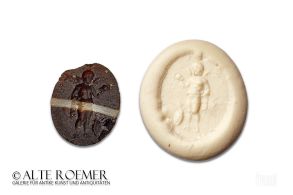 Roman intaglio with Eros as child god
Roman intaglio with Eros as child godThe Roman intaglio is made of banded glass paste. It show the god standing with a bowl in one hand. From the Professor Brosch collection of engraved gems.
Price: on request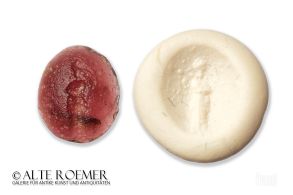 Roman intaglio made of beautiful glass paste
Roman intaglio made of beautiful glass pasteThe piece from the Professor Brosch collection shows a standing woman. Wonderful violet colour.
Price: on request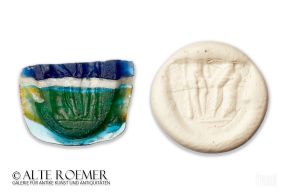 Roman intaglio with Heracles
Roman intaglio with HeraclesThe glass paste is of wonderful blue and green colour with a white band. It shows the young Heracles with his club.
Price: on request Stirrup vessel as a water bird
Stirrup vessel as a water birdPlastically shaped vessel from the Peruvian Chimú culture, showing a water bird. From the 15th century. With TL report from 1979.
 Trumpet brooch with Celtic decorations
Trumpet brooch with Celtic decorationsUnusual and rare variant of high importance, published several times. Beautiful silver inlays on the bow showing tendrils in Celtic style. From the 1st century.
Price: on request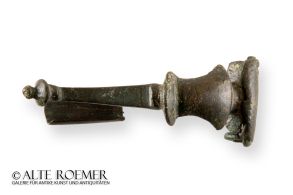 Roman Kraeftig Profilierte fibula
Roman Kraeftig Profilierte fibulaFibula with noble green patina. An import from mainland Europe to Roman Britain. From the 1st century AD. Published in two stardard works on ancient brooches by Richard Hattatt.
Price: on request Roman lentoid glass flask
Roman lentoid glass flaskThe flat bottle has a discoid body with a very long neck. Probably from the Roman province Judaea.
Price: on request Victorian ink bottle
Victorian ink bottleThe vessel is made of beautiful, turquoise glass. From the collection of Moshe Dayan.
Price: on request
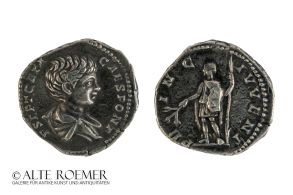 Extremely fine Geta denarius
Extremely fine Geta denariusThe obverse shows the emperor standing left in military attire, holding spear and branch. Wonderful dark patina
Price: on request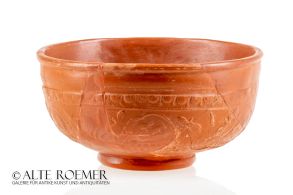 Terra Sigillata bowl from the Rhineland with hares and birds
Terra Sigillata bowl from the Rhineland with hares and birdsFound near the Roman city of Novaesium, today's Neuss in Germany, an early Roman foundation and with this one of the oldest cities in Germany.
Price: on request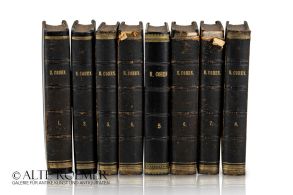 Very rare Henry Cohen 1880 - 1892 edition
Very rare Henry Cohen 1880 - 1892 editionDeuxième Édition. Paris - London 1880 - 1892. Contemporary half-leather binding with golden letterae. A highlight for every numismatics literature collection.
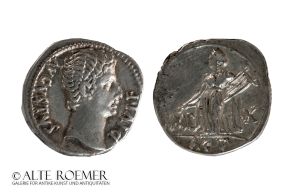 Extremely fine Augustus denarius commemorating Battle of Actium
Extremely fine Augustus denarius commemorating Battle of ActiumThis issue commemorates the victory of Octavian (Augustus) over Mark Antony and Cleopatra at the Battle of Actium in 31 B.C.
 Roman legionary tile from the Rhineland
Roman legionary tile from the RhinelandLEG XVI (Gallica), 43 - 70 AD. Found 1966 till 1981 near the Roman city of Novaesium, today's Neuss in Germany. Novaesium was an early Roman foundation and with this is one of the oldest cities in Germany.
Price: on request Marc Antony legionary Denarius from Wishanger hoard
Marc Antony legionary Denarius from Wishanger hoardFound 2021 in East Hampshire, UK. The hoard is a very impressive proof of the fact that coins were in circulation for up to several centuries in the Roman era.
Price: on request Hellenistic terra cotta horse protome
Hellenistic terra cotta horse protomeAbout 4th - 3rd century B.C., a very similar figurine is on exhibition in the Metropolitan Museum of Arts. From the old German private collection H. Deikner, acquired prior to 1980.
Price: on request Celtic coin - Iceni tribe
Celtic coin - Iceni tribeEast Anglia mint, reported to have been found in Stonea Grange, Cambridgeshire.
Price: on request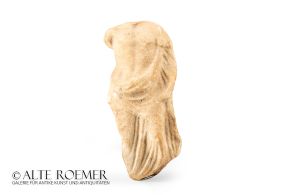 Hellenistic or Roman marble torso
Hellenistic or Roman marble torsoFrom an old German private collection, acquired 1962. Impressive piece.
Price: on request

